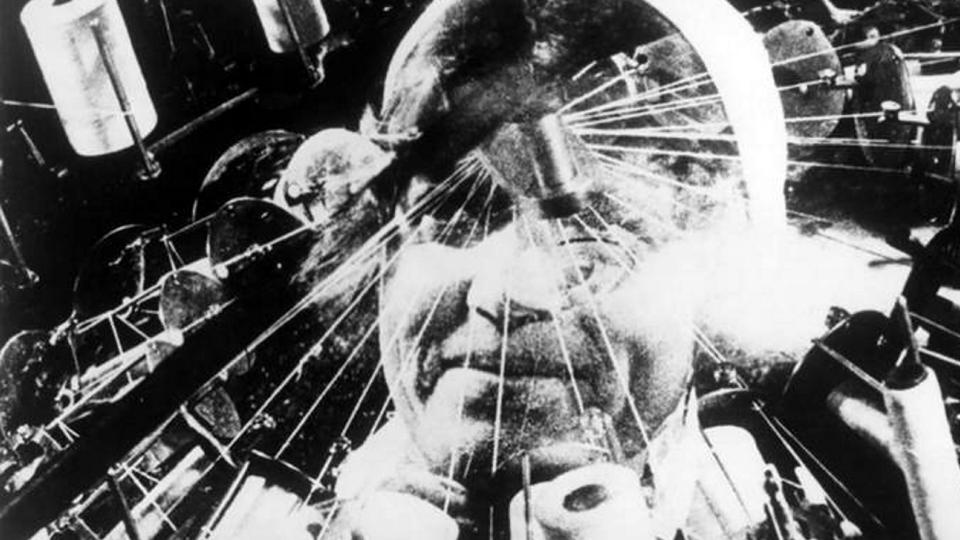The miracle of the movies has long been said to be not the way they wrangle and conform all preexisting means of artistic expression into one mass medium, but the way that in so doing, they enabled mankind, for the first time, the possibility to literally communicate in the method of thoughts, memories and dreams. People, places, things in motion – like never, ever before. Thoughts on a shared screen moving, cutting and changing just as they do in our heads.
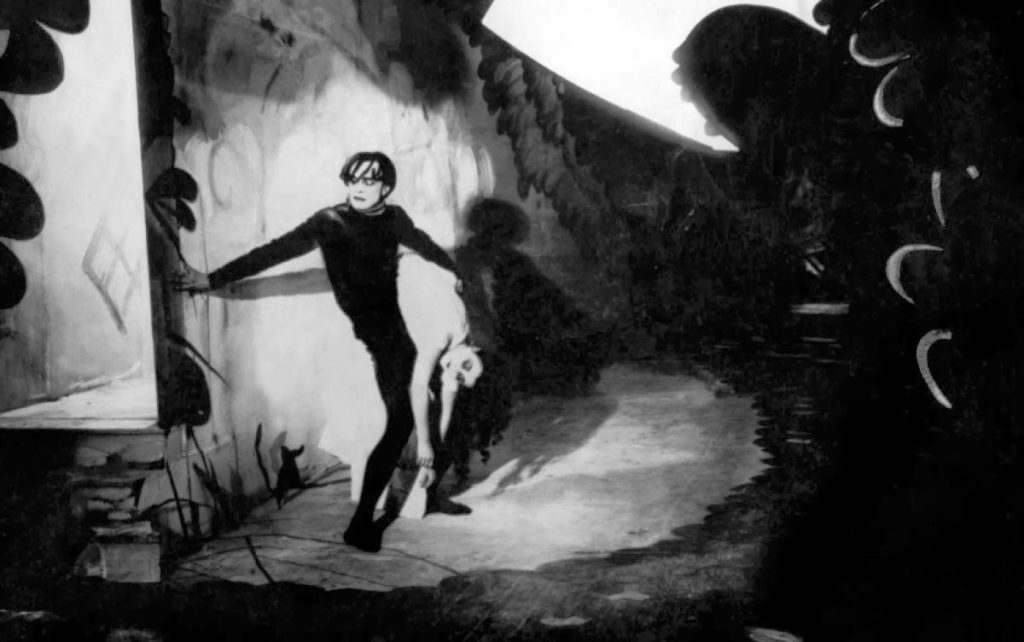
THE CABINET OF DR. CALIGARI, 1920, dir. Robert Wiene
That the medium and the moviemaking technology settled so quickly into primarily being a means of narrative storytelling tells us something about ourselves, and no small thing at that. Of course, no two heads bear the same thoughts, ideas, and perceptions. Reality, though, is locked in. Therefore, we look to talented directors, actors, screenwriters, producers, cinematographers, production designers, makeup people, prop makers and buyers, electricians, wardrobers, composers, editors, stuntpeople and visual effects specialists to collaborate in the name of telling us good stories about this reality we share. Good stories delivered in a way we can all conceivably enjoy and consider them.
In a business all about entertaining via a good show (or a thrilling show or a horror show or what have you) through a collaborative medium that demands exhausting hours of battlefield-level strategies and executions, the personal visions, thoughts and messages nonetheless often survive the fray, resulting in a piece that is worth one’s time. In rare, wondrous cases, the finished works transcend to the level of the indelible, imprinting our subconscious. They return in a grand loop to where they originated in the first place.
What follows are six separate considerations of enduring films that stand out from the pack in terms of psychology. Whether they’re engaging psychology from a visual filmmaking standpoint, or more directly in the story being told, or both, these are the individual titles that sprang to mind for six different ZekeFilm regular contributors when the words “Psychology” and “Film” were uttered together. That’s our story, for now. We hope you enjoy this collection of short essays and maybe, perhaps, are enriched by them…
– Jim Tudor
The Silence of the Lambs
1991, Orion Pictures, dir. Jonathan Demme
by Jeffrey Knight
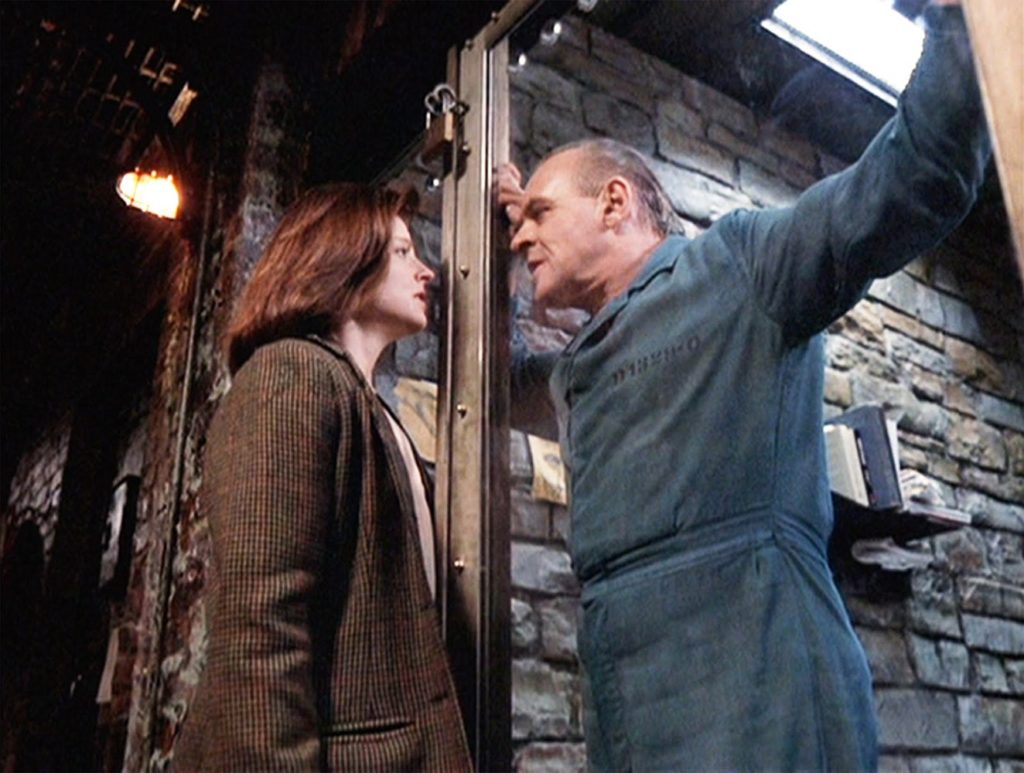
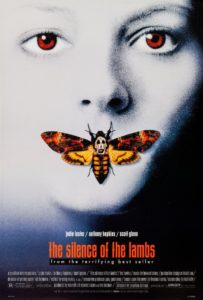 Upon its release in 1991, The Silence of the Lambs, directed by Jonathan Demme, was a huge hit. Made on a budget of an estimated $19 million, the film grossed $273 million worldwide making it the fourth biggest film of 1991. The movie also garnered praise from critics. It would go on to win five Academy Awards, including Best Picture, Actor, Actress, Director and Adapted Screenplay. A copy of the film is preserved in the National Film Registry, and it routinely makes “Best Movies of All Time” list, such as those by the AFI.
Upon its release in 1991, The Silence of the Lambs, directed by Jonathan Demme, was a huge hit. Made on a budget of an estimated $19 million, the film grossed $273 million worldwide making it the fourth biggest film of 1991. The movie also garnered praise from critics. It would go on to win five Academy Awards, including Best Picture, Actor, Actress, Director and Adapted Screenplay. A copy of the film is preserved in the National Film Registry, and it routinely makes “Best Movies of All Time” list, such as those by the AFI.
Consequently, as most successful films oftentimes do, Silence spawned its own sub-genre of thrillers, the “Genius Serial Killer” movie. Films in this genre include Se7en (do I really have to put that number in there?), Kiss the Girls, The Bone Collector, and Copycat. Silence also spawned three sequels and a TV series. Films in this genre pit law enforcement (usually played by Morgan Freeman) against a murderous psychopath who’s playing four-dimensional chess while the cops are playing checkers. Shadows of this genre are still felt in films like The Dark Knight, Skyfall and Star Trek Into Darkness (bonus points if the film uses the phrase “He wanted to get caught!”).
None of these other films, however, made the impact that The Silence of the Lambs has. The extraordinary filmmaking of Jonathan Demme and the performances of his leads, Jodie Foster, Anthony Hopkins, and Ted Levine are no doubt a huge part of that. But there’s also the story’s treatment of the psychology of its characters. This is, oddly enough, important in a ‘psychological’ thriller.
The films that followed Silence all had scenes of worried law-enforcement personnel staring at case files and muttering “we need to figure out how the killer thinks!”, but too many of them relied on a comic-book level of psychological understanding (or worse, a scriptwriter’s level). The killer’s motives needed no more explanation than ‘He’s insane!’ and that was enough to drive any number of Rube Goldbergian murder devices and convoluted plots.
Silence treats with its principals fairly, however. The death of Clarice Starling’s father and her subsequent experience with the lambs on the ranch left her with a lingering Post Traumatic Stress. Hannibal Lecter’s Antisocial Personality Disorder shows itself in the way he finds amusement in saying hurtful and shocking things to people, the way he lies and manipulates them, the calmness he experiences even while physically brutalizing someone, and, yes, in the way he eats them. Jame ‘Buffalo Bill’ Gumb synthesizes the two. “Our Billy wasn’t born a criminal,” Lecter says, “He was made one through years of systematic abuse.” Gumb’s ongoing childhood trauma combines with his own Antisocial Personality Disorder into a strong sense of self-loathing and a total disregard for the personhood of other people (though strangely not his dog, who he displays genuine concern for).
Now these aren’t necessarily ‘realistic’ depictions of these real-world disorders, but they are treated in the story with a degree of understanding beyond an umbrella declaration of ‘insanity.’ Thomas Harris’s research into the motives and methods of real-world serial killers such as Ed Gein was reflected in his novel, and the movie carries that forward in its screenplay adaptation. The films that followed, however, only used previous films like Silence as research. They are copies of a copy and lose a lot of what makes Silence work. They oftentimes get the thriller part right, but they lose sight of the psychological, and that makes all the difference. Silence shows us the humanity of even the most inhuman characters, and that’s a huge part of the reason it still endures as a classic.
Bigger Than Life
1956, Twentieth Century Fox, dir. Nicholas Ray
by Robert Hornak
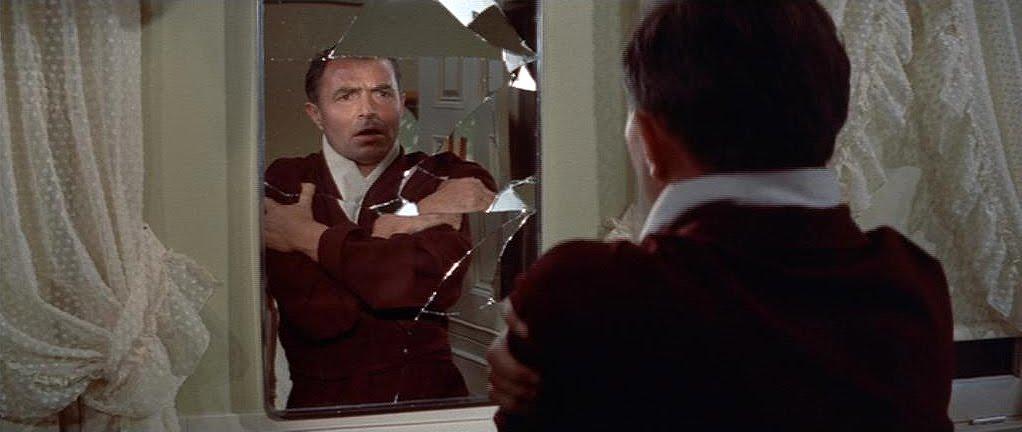
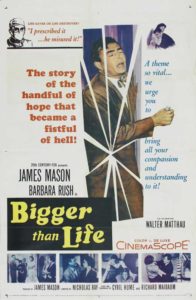 Right smack in the middle of the halcyon ’50s, land of Ozzie and Harriet and Father Knows Best, Nicholas Ray made a tall tale of middle America gone completely heels over head, lighting a slow-burning fuse under the nuclear family. James Mason is Ed, a mild-mannered teacher whose domestic bliss is right away stained with something other and ominous – in the center of a typically pristine kitchen, complete with dutiful wife, stands an ugly, rusted water heater, domesticity about to blow. But the more overt signs of looming family tragedy are the pains radiating out of Ed’s searing gut, grinding the meat of his angst, the realization of his and his entire family’s “dull”ness. This just before he collapses and gets medicated to the gills with the new wonder drug cortisone, its presenting side effect an eventual megalomania channeled into a sweaty crusade to make his family the perfect unit in the most extreme ways.
Right smack in the middle of the halcyon ’50s, land of Ozzie and Harriet and Father Knows Best, Nicholas Ray made a tall tale of middle America gone completely heels over head, lighting a slow-burning fuse under the nuclear family. James Mason is Ed, a mild-mannered teacher whose domestic bliss is right away stained with something other and ominous – in the center of a typically pristine kitchen, complete with dutiful wife, stands an ugly, rusted water heater, domesticity about to blow. But the more overt signs of looming family tragedy are the pains radiating out of Ed’s searing gut, grinding the meat of his angst, the realization of his and his entire family’s “dull”ness. This just before he collapses and gets medicated to the gills with the new wonder drug cortisone, its presenting side effect an eventual megalomania channeled into a sweaty crusade to make his family the perfect unit in the most extreme ways.
Ed’s young son, Richie, wears a red jacket that renders him a pint-size Rebel Without a Cause, and we’re likely to think of poor, weak Jim Backus in that film (made by Ray the previous year) against the diametrically opposing sight of Mason’s Bigger Than Life patriarch made strong, and stronger and stronger, until he’s a dominating monster, like James Dean got his wish and then lived to tell the war story. And it’s not just that Ed feels better, he’s become smarter, more spontaneous, more generous, and later more demanding, suspicious, shrill, and authoritarian – psychosis as character arc. An act-break transformation from squirrelly schoolmarm to the Henry VIII of the suburbs shows Ed deepening his stump speech so its paternal-sadist colors fly free: “Childhood is a congenital disease and the purpose of education is to cure it,” he decrees. The last half of the movie is a morality tale that, along the way, presumes the futility of morality at all by pushing the logic of morality in a broken world to the point of absurdity. The mania descends into Old Testament on Main Street when Ed goes all Abraham and seeks to murder his son on the altar of childhood laziness. It’s all very proto-Shining, with the trappings of ’50s filmmaking pressed out to the limit, making it more dementedly psychotic than anything else from the era.
It’s a sideways Jekyll and Hyde, where Hyde isn’t a shrunken Neanderthal of id run amok, but a desperately overbearing taskmaster unafraid to break Richie’s spirits with a withering stare of disappointment or, you know, the brandishing of a sacrificial knife. Ray links the acquisition of the perfect family with Biblical reckoning but also with broad elements of horror movie tropes like heavy music and dark, shadowy lighting, even at the climactic “happy ending” when the family unit is restored with tight hugging and desperate smiles of relief, but the hard shadows and cramped blocking tell a different story, as if to acknowledge: these things are never wrapped up with a Hollywood denouement. We’re left to anticipate a sequel, maybe called Proportional To Life, detailing the roiling saga of long-term family counseling.
Silver Linings Playbook
2012, The Weinstein Company, dir. David O. Russell
by Krystal Lyon
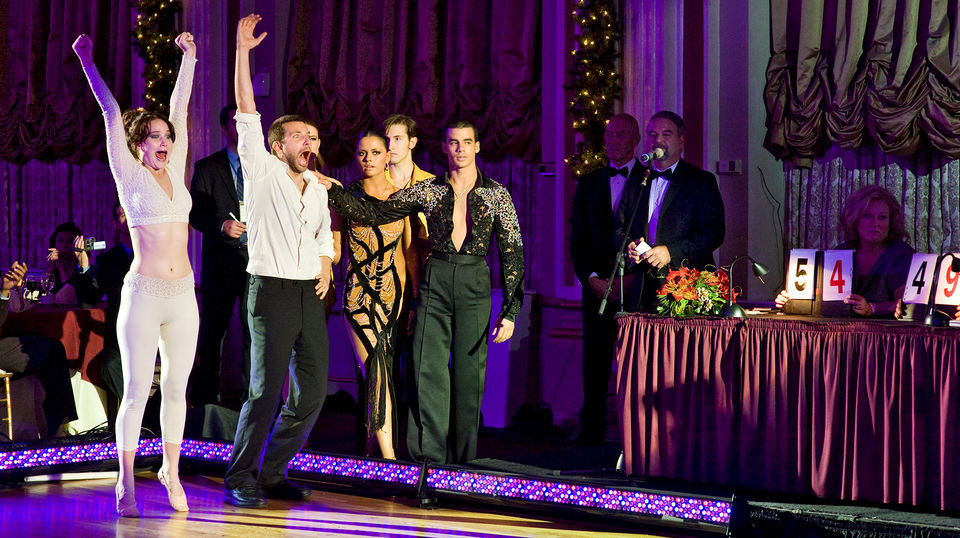
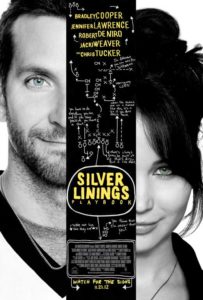
To quote my mom, “We all need a win.” And in David O. Russell’s personal triumph Silver Linings Playbook we get that “win” in one of the most joyful scenes I have ever witnessed on film. If you aren’t familiar, Silver Linings Playbook follows Pat Solitano (Bradley Cooper) after a bipolar break and a stint in a mental care facility. He moves back in with his parents, Pat Sr. (Robert De Niro), and Dolores, (Jacki Weaver) and is working hard to control his rage and improve himself so he can win back his wife. Meanwhile, Tiffany, Jennifer Lawrence, has recently lost her husband in a car accident. She used copious amounts of sex to deal with her grief but finds that leaves a trail of chaos and instead tries her hand at ballroom dancing. Through a couple of awkward dinners and multiple run-ins over jogging the two connect and make an agreement to help each other out. And with these extreme atypical characters David O. Russell gives us his unconventional version of a rom-com. While it is not your average comedy or romance Silver Linings Playbook struck a chord and was a huge success garnering 8 Oscar nominations and a Best Actress win for Lawrence. So what makes this mixture of mental illness, romantic and comedy a hit? Let’s look at three scenes in the film, one funny, one heartbreaking and then that joyful one mentioned above to see the connection.
The first is a dinner scene at the home of Ronnie, John Ortiz, and Veronica, Julia Stiles. Ronnie is Pat’s best friend and Veronica is Tiffany’s controlling sister. Pat and Tiffany both arrive not knowing the other is coming and instantly stress out the “normal” couple by commiserating over their medications. Some people connect over music, others politics, but for these two the social walls crumble when they talk about the side effects of Klonopin. With such hard subject matter you would think the scene would feel heavy, instead through genius dialogue and fantastic reactions from the actors O. Russell keeps the entire scene light hearted. This interaction felt like a release, the pressure was off and truth was on the table. Every character is flawed and dealing with life in their own way and it was refreshing to see that on an awkward first date.
The second scene is when Pat comes home from that double date. He struggles with his attraction to Tiffany while wanting to remain faithful to his estranged wife. To combat these feelings he decides to watch his wedding video in the middle of the night. He wakes up his mother and father and a whirlwind of miscommunication and rage ensues. The night ends with the neighborhood gawking at the Solitano family, a police officer on the premises and Pat Sr. with a black eye. O. Russell gives the viewer a glimpse of the damning memories that are dragging Pat into this downward spiral. Your heart breaks for all involved and you instantly relate this story to stories that you know all too well. Silver Linings Playbook connects because it shows you that your own heartbreak and struggles are not solitary in this world.
But let’s end on a high note, or with that “win”. Remember Tiffany and Pat made an agreement to help each other out and that culminates in the dance competition at the Ben Franklin Hotel. They need a score of 5.0 to win a bet for Pat Sr. and Tiffany thinks that Pat will leave her when the competition is over, so emotions are high. The dance is piece of theatrical joy, you are smiling and laughing and holding your breath the entire time. I dare you not to smile during that scene! Silver Linings Playbook ends on an up swing, all is right on game day Sunday in the Solitano home. There are some who say that ending is a lie, the truth is Pat and Tiffany both have years of struggle and meds and therapy in their future. But instead, O. Russell offers us a breather, a memory of joy to minimize those other memories that haunt. He gives us a story of hope and it’s an awkward beauty to behold!
Lars and the Real Girl
2007, MGM, dir. Craig Gillespie
by Sharon Autenrieth
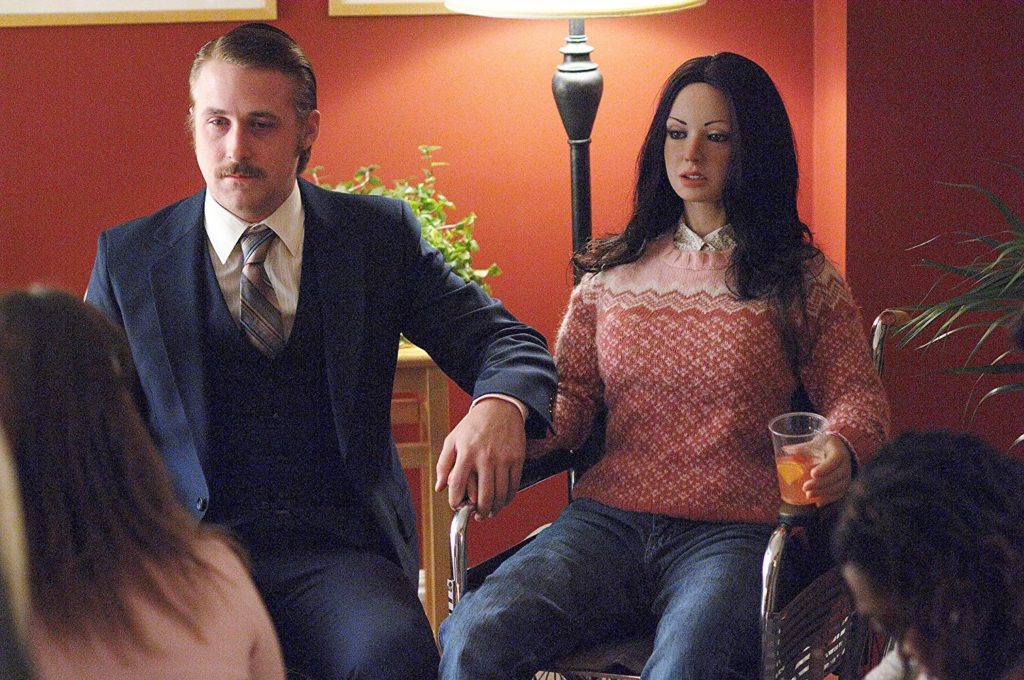
 Just a few minutes into Lars and the Real Girl, we overhear part of a sermon delivered in a Lutheran church in a small Wisconsin town. As Lars Lindstrom (Ryan Gosling) sits alone in his pew we hear the minister Rev. Bock say, “In all the world there’s really only one law…We need never pray, ‘Lord, what shall I do?’ because the Lord has already told us: ‘Love one another.’ That, my friends, is the one true law. ‘Love one another’ is God in action.”
Just a few minutes into Lars and the Real Girl, we overhear part of a sermon delivered in a Lutheran church in a small Wisconsin town. As Lars Lindstrom (Ryan Gosling) sits alone in his pew we hear the minister Rev. Bock say, “In all the world there’s really only one law…We need never pray, ‘Lord, what shall I do?’ because the Lord has already told us: ‘Love one another.’ That, my friends, is the one true law. ‘Love one another’ is God in action.”
For the rest of Lars and the Real Girl, we see the people of that town live out that one law. Lars is one of their own, he needs their help, and they will do whatever love requires.
To say that Lars is painfully shy doesn’t begin to describe the situation. He lives in a garage behind the home he grew up in, now occupied by his older brother, Gus (Paul Schneider) and pregnant sister-in-law, Karin (Emily Mortimer). Lars functions (he goes to work and church), but interacts with others as little as possible. Even convincing Lars to share a meal with his family is a herculean task for Karin, who frets over Lars’ isolation while Gus suggests they leave him alone.
When Lars suddenly shows up for dinner with a sex doll that he calls Bianca – a missionary who from Brazil is who is now “seeing the world”, Lars tells them – Gus and Karin both finally agree there’s a problem. They turn to the local family doctor who is also trained as a psychologist and Dr. Dagmar (Patricia Clarkson) suggests that the only way to help Lars with his delusion is to let him work through it in his own time. Act as if Bianca is “real”.
I can’t think of a kinder picture of a small Christian community than is found in Lars and the Real Girl. Once convinced by Dr. Dagmar, Gus and Karin go to their friends, co-workers, and church family to explain what’s happening and ask for their help. Of course, there’s some shock and laughter, and one church board member loudly protests that Bianca is a “golden calf”. But he is reminded by an elderly woman that Lars is a “sweet boy”, one they’ve watched grow up. “What would Jesus do?” the pastor asks, and the answer is offered in the next scene, with Bianca seated in her wheelchair, right alongside Lars in the Sunday service.
When I saw Lars and the Real Girl ten years ago, I couldn’t help but try to diagnose Lars. It was not the delusion that drew my attention, so much as his severe social anxiety. He is a bundle of tics and anxious, empty smiles. Lars shrinks from human touch but wraps himself in security objects. I wondered then, “Is he on the spectrum? Is that what Nancy Oliver intended?” I think now that question was all wrong. It was wrong because there’s no mystery to why Lars is as he is: he is a young man born in tragedy and raised in grief, without any opportunity to process what he lost or what it meant. The people who have known Lars all his life, his brother above all, seem to have missed how deep the wounds are, how afraid and lonely Lars is. But they know now: Bianca is the mediator through whom Lars can finally speak, share his questions, even learn to express anger. Most of this movie is set in a Wisconsin winter, and not by accident. It takes a long time for a spring thaw to really come in Wisconsin, and Lars’ own thaw is a slow and laborious process.
It would be inaccurate to say that Lars doesn’t receive mental health care: he sees Dr. Dagmar every week, as she cleverly “treats” Bianca for an unexplained illness while really caring for Lars. The rest of the community simply shows compassion and tolerance. When Lars brings Bianca to an office party, she is welcomed along with him. When Bianca is sick, the church ladies bring casseroles and sit with Lars. The townspeople even use Bianca to help Lars learn what a healthy romantic relationship looks like – they find Bianca a part time job and volunteer opportunities so that Lars will be forced to spend time away from her, and one of the church ladies scolds Lars when she thinks he’s being too possessive and controlling of Bianca’s time.
Is love enough to heal? Not always, unfortunately, and the church has often erred in discouraging those with mental illness from seeking counseling or medication. But medical treatment is certainly more effective when we are in a community of people who love us, who accept us in our weakness, who are willing to do for us what love requires. “What will people think?” Gus frets, after first seeing Bianca. “We can’t think about that,” Karin replies, knowing that Lars’ well being is a higher concern than their reputation. But Gus needn’t have worried, because for the most part the answer to “What will people think?” turns out to be, “How can we help? What does Lars need from us?” We’re not meant to struggle alone. Isolation is what brought Lars to this point. Healing happens in a community that follows the one true law: “Love one another.”
The Babadook
2014, Screen Australia, dir. Jennifer Kent
by Paul Hibbard

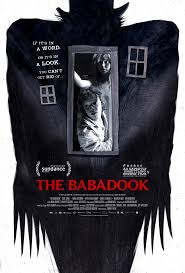 In The Babadook, Amelia is dealing with grief from her husband dying. It is a pain that cannot be ignored, though she has tried. It will always come back.
In The Babadook, Amelia is dealing with grief from her husband dying. It is a pain that cannot be ignored, though she has tried. It will always come back.
Her son Samuel is also dealing with that pain, but being a child, he has not developed the cynical approach to life Amelia has by ignoring problems. He has no choice but to deal with them head on. He screams, throws tantrums and has fits. This just adds to the problems in Amelia’s life and causes her to entrap herself further into the personal hell that she lives in.
And the babadook himself is nothing more than the manifestation of that grief. When it comes up, she ignores it. Instead of other horror movies, where the characters further investigate, she acts like it isn’t happening. There’s no priest being brought in, like The Exorcist; no paranormal hunters, like Insidious; no cameras set up to catch what is happening, like Paranormal Activities.
Just ignore the problem.
One of the complaints from people who disliked The Babadook, which I would classify as people who misunderstood it, was how ‘annoying’ Samuel’s character is. Not only does actor Noah Wiseman give a loud and eccentric performance, but that feeling you are feeling is intended. It’s not annoyance, but rather the point. The point that you cannot sweep problems under the rug.
Amelia is suffering from postpartum depression and they are both suffering from PTSD. The conflict between the two and the way the director holds shots dealing with their tumultuous relationship does not take away from the film, but rather is the point of the movie.
Since the film has been released, there has been an embracing of the babadook (the creature), as he has become popular in memes and even a symbol of the LGBTQ community. This is because whether the viewer caught it or just senses it, he is not a villain to be feared, but the grief that has to be faced for us to move forward in life in a healthy way.
Shadow of a Doubt
1943, Universal Pictures, dir. Alfred Hitchcock
by Jim Tudor
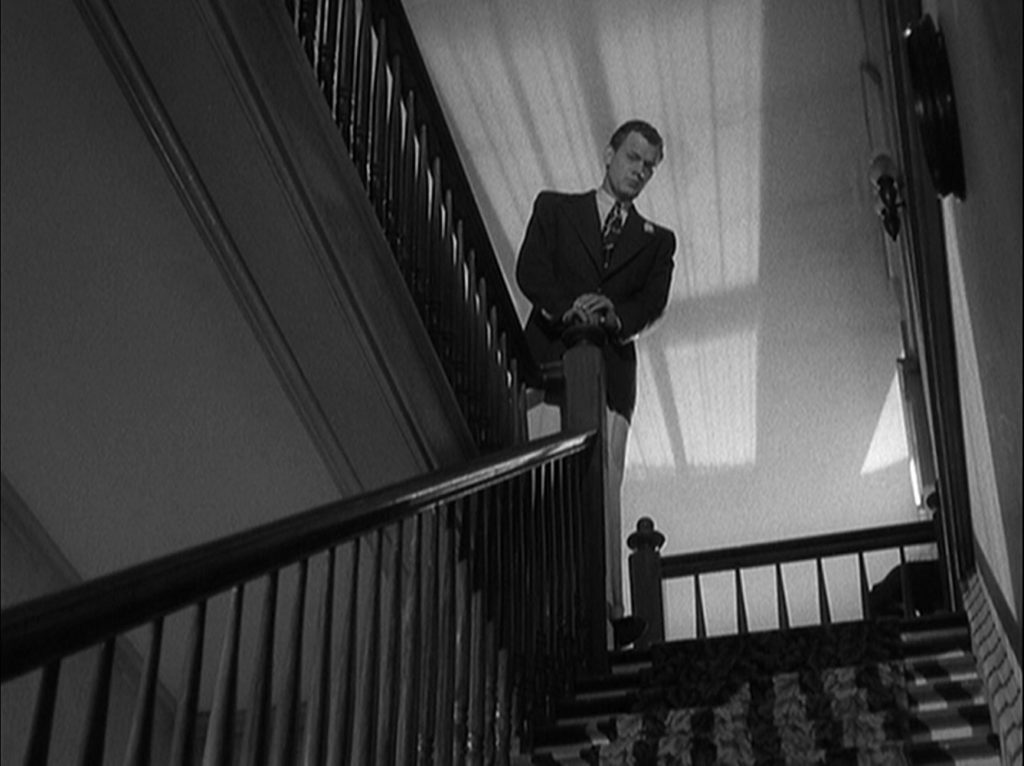
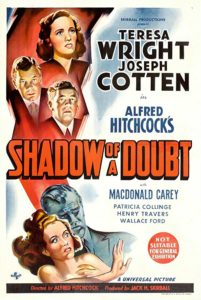 Shadow of a Doubt, though admired by those in the know, somehow remains in the dimly lit recesses of the venerated Hitchcock filmography. That it’s said to be Hitchcock’s favorite of his own movies should come as no shock, considering its firm themes of light and dark morality, and the psychological knots that people nonetheless bring to such truths.
Shadow of a Doubt, though admired by those in the know, somehow remains in the dimly lit recesses of the venerated Hitchcock filmography. That it’s said to be Hitchcock’s favorite of his own movies should come as no shock, considering its firm themes of light and dark morality, and the psychological knots that people nonetheless bring to such truths.
Considering Hitchcock’s trademark sardonic wit and fatalistic humor, it may come as a surprise for some that the filmmaker carried with him, for life, distinguished remnants of his devout Catholic upbringing. Rarely is the imprint more discernible than in Shadow of a Doubt, a film in which cinema’s typical practice of examining relationships and sociology via spiritual metaphors is reversed. In very true Hitchcock form, the actors, with their characters and situations, are merely playthings in his grander scheme. The relationships and sociology still matter greatly, but the bottom line in Shadow is the duality and conflict between fundamental, reality-defining good and evil.
Teresa Wright, radiant and pure as anyone in any movie has ever been, is teenage Charlie. She’s named after her uncle, a wealthy man of the world she thinks the world of (a sinister Joseph Cotten, only two years off of his screen debut in Citizen Kane). Together they are an uneasy yin and yang of WWII American morality, security, and values. Though young Charlie believes it to be a miracle that uncle Charlie turns out to be headed into town just as she went to telegram for his presence (her family has been “in a rut” – a visit from her mother’s brother would be just the thing to get everyone on their feet again), it is only ever she that picks up on his true nature. Hitchcock delivers each reveal with perfect empathetic precision: The slow dolly-in on the side of his face as he details his disdain for “merry widows”; the sudden bombastic reading of the newspaper article. Guy punches to varying degrees, but gut punches all the same.
Before Heath Ledger’s Joker ever took a match to a pile of cash, Joseph Cotten’s uncle Charlie also disregarded his stolen fortune, if only in part to “watch the world burn”. To be sure, Charlie is a more principled evil than the Joker of The Dark Knight (2008), tightly wielding a homicidal ideology rooted in something like particularly twisted Darwinism. His “Merry Widow Murderer” persona – his true face, indeed – maintains that wealthy grieving widows are the bloated, self-pampering bougiesie of the world, too repulsive to live. Or is it that their tragically acquired independence is something that no matter how far he runs, he can never find? There is no solace for this killer; no deserved sympathy or this devil. He is nothing short of repulsive, pure diabolism; an undetected lung cancer in a community that didn’t even know it craved his brand. Truly, one of the most terrifying things about Shadow of a Doubt isn’t that the devil comes to the idyllic suburbs, but how easy it is for him to hide there. Decades later, David Lynch would cop the notion for his own version, Blue Velvet (1986).
Interestingly, perhaps subversively fittingly, Shadow of a Doubt eludes the brutal truth of the Second World War (at a fever pitch during its production and release) the way that it’s characters elude the outside world. It goes about its business of addressing a different kind of menace, the one at home. Back then, it was internment camps and paranoia. Today, declared Nazis and people sympathetic to their viewpoint are indeed in our national midsts. Again we see that beyond the shadow of a doubt, Hitchcock was onto something, something bigger than his own time and place.


